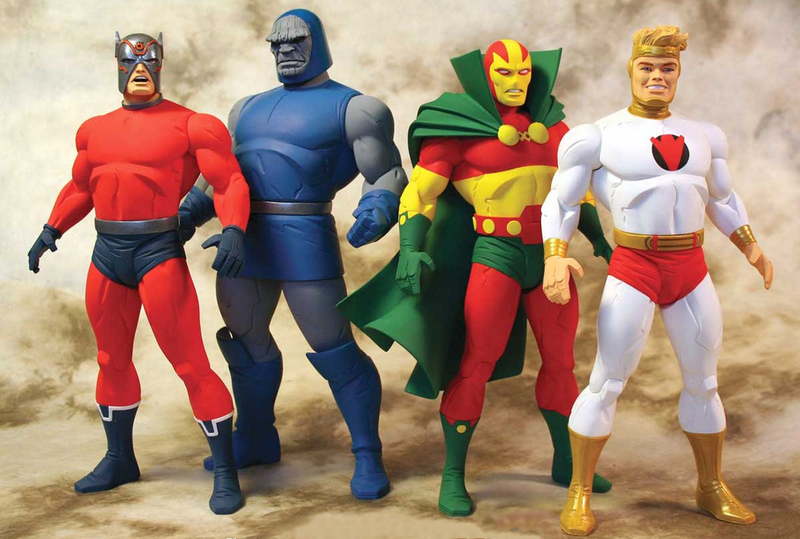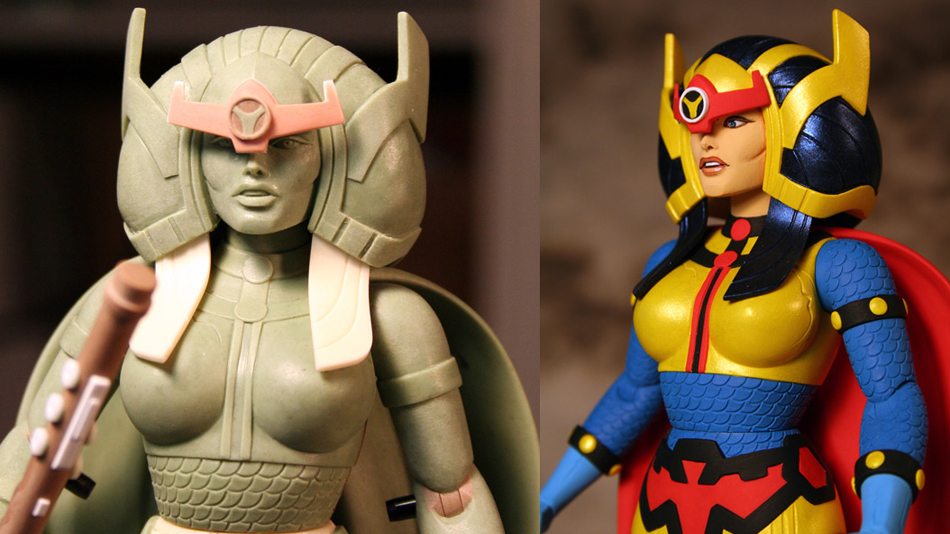1. Who is Jonathan Matthews?

I’ll resist the urge to refer to myself in the third person here… I’m a guy who sculpts action figures and collectible statues for the comics industry. I’ve been working exclusively with DC Comics for the last decade, but have previously done work for other companies like Diamond, Graphitti, and a few others small enough that most wouldn’t recognize. I’m a freelance artist for all practical purposes and enjoy art in most of its forms. I like to draw and paint as well as sculpt.
I’m a father of twin girls and husband to an artist wife. I work out of my home in Louisville, Kentucky.
2. You studied at CCAD (Columbus College of Art and Design) to become an illustrator. What drew you to sculpting?

I’ve always enjoyed sculpting actually. I used to spend as many hours with modeling clay as with pencils as a kid. When it came time to pick a college, Illustration just seemed the most likely way for me to earn a living in art. I kept up with my sculpture work while refining my 2D skills and would sometimes do three-dimensional illustrations for class projects… that is, I would sculpt/build a set and characters then photograph it and turn in the print as my assignment.
I had a class in college that delved into some of the exact things I do for my job as a comics sculptor. In the class, we did life-size foam and latex creatures experimented with various sculpting materials and learned to reproduce sculptures using silicone and resin.
3. How do you begin a new project?
At the beginning of each project I do, I have a conversation with my Art Director. He or she will first show me the project to ensure it’s something I’m interested in. Once we agree on the project and price, I’ll be sent a packet of reference for the project I’m to produce. Most of the work I do is representative of artwork that appears in comic books, so my reference is typically a collection of various comic panels that show my subject character from all angles. Sometimes, the comic artist whose style I’m emulating will do a drawing specifically for the project. After I’ve compiled all the reference I’ll need, I start carving wax.
4. Do you still model your initial figures traditionally or have you switched to digital modeling?
I’m still doing all my projects traditionally, though I’m studying the software for digital sculpture.
5. What is your process for creating an action figure?

As I mentioned previously, I compile reference first. When I’m ready to start the sculpture, I use a wax called Castilene to rough in the figure. The wax is pretty hard at room temperature, so I heat chunks of it under a light bulb to soften it. I use the soft pieces to build up a roughly human form and add or subtract wax as necessary to match the proportions of the reference art. I’ll refine the wax figure until it looks like the artwork, then send photos from all angles of the figure to my AD (art director) for his or her input or corrections. I’ll send in photos several times during this process so my AD can track my progress and be sure the piece looks as it should. Action figures I create have working articulation, so during the sculpting process, I build in joints that move as the final production piece will. I get the final polished finish on the whole figure using a combination of dental/sculpting tools, butane torches and sandpaper.
6. Do you use a lot of armatures within your sculptures?
I use almost no armatures at all in my sculptures. The wax I use is pretty hard at room temperature and is self-supportive for the most part. If any part of the sculpture is really thin, I’ll sometimes add wire to strengthen that area. Sometimes I’ll make an armature for a figure’s hands since the fingers are so small and prone to breakage.
7. Do you have a hard time stepping away from a finished project or do you find yourself fiddling with it until the last minute?
No. I do sometimes finish a sculpture with a finer polish than is necessary, but it’s pretty obvious if a figure is done or not. Once they’re finished I move on to the next one.
8. What drew you to doing primarily comics work?

Happenstance, really. I had some classmates in college who upon graduation got jobs at a small toy company in town. They remembered some of my sculptural work from school and called me out of the blue to see if I’d be interested in sculpting an action figure. I took a few sculptural pieces in to show their bosses and left with a reference pack for my very first action figure. I finished the figure for them and they immediately offered me a job on staff there. The company went out of business a year or two after I began (I tell myself the company’s demise had nothing to do with me) but I still work with some of the same people today. My AD from DC Collectibles was on staff in my department at this same small company.
9. Do you find yourself struggling with projects that defy realistic anatomy, as in the Mignola Batman?

Not at all. In fact, I find that the more stylized a comic artist draws, the easier it is for me to hit the style sculpturally. An artist like Mignola invents his own brand of human anatomy and if I can hit a few key visual cues in my sculpture, the effect is successful. I find I really enjoy creating three-dimensional interpretations of comic art especially if the 2D work is heavily stylized.
10. You live in Louisville, KY (as do I). What makes you stay in this area as opposed to living in one of the larger comic production based cities?
My job is a solitary one. I spend most of my week with myself and my work. Other than the few times I send photos to my AD, his or her involvement in my day to day is minimal. I’m able to send in the finished project through the mail, so it really doesn’t matter where I live. I can still be a part of DC’s creative team. There may be some advantages to being close to the office, but those offices are in large cities on either the east or west coast. Cost of living is a factor there. I grew up around here, so I came back here to start a family.
11. Is there a character that you would love to work on?

I grew up reading Batman comics and he’s always been one of my favorites. I never get tired of doing Batman figures, but the bulk of my portfolio consists of Batman sculptures. That said, I enjoy doing more obscure characters. I love sculpting Darkseid, Big Barda, and some of the other New Gods characters. I’ve done a Killer Croc, and love that guy too. I’ve never done a Clayface, but have always wanted to.
12. What piece of your own work are you most proud of?
I’m pretty proud of a lot of them, but I’d have to say the Mignola Batman black and white statue is the standout. It’s the piece of mine that’s most recognizable to fans and one that has been produced time and again.
13. Do you have mentors or people you admire?
Sure! For mentors, my main pick would be an illustrator named Dave Groff. He was one of my teachers at CCAD and gave me a start working for him at his studio right out of college. For people I admire, there’s a pretty robust list of sculptors and painters that could go on for a page or so. To name a few: Takayuki Takeya, Yasushi Nirasawa, Simon Lee, Frank Frazetta, Simon Bisley, Gregory Manchess… Like I said, I could go on and on, but I’ll stop there.
14. What would you be doing as a career if you weren’t a sculptor?
Probably an Illustrator. Who knows?

15. What toys, figures, and sculptures do you collect?
Uh, there’s a lot! I’ve got an embarrassingly large collection of toys and statues. Most the stuff I go for is Japanese and high end. I’ve got a lot of those die-cast metal robots from Bandai’s Soul of Chogokin line. Most of those are the same robots from the Shogun Warriors cast of characters. There are a few of my own statues around my studio, but most are from my collection.
16. What books are on your nightstand right now?
Just the one right now: Ray Bradbury’s “A Sound of Thunder” Most of the books I “read” are audio books that I listen to constantly while working.
17. Would you do illustration work if the opportunity came or are you more comfortable in the 3D world now?
Well, I’m definitely more skilled as a sculptor, but I can still draw pretty well. I do stuff now and then for friends or for small group art shows, but most of my drawings and paintings I share here in my studio.
18. What is on your work table right now?
A bunch of wax parts for action figures and statues. There are some Darwyn Cooke and Greg Capullo action figure parts and some Batman black and white parts. I’m working on a Batman black and white statue, but I can’t tell you who the artist is. You’ll have to wait!
19. What would you say to a young person interested in becoming a sculptor?
Study the digital sculpting programs and make sure you have a backup career in mind.
20. Where can people follow you on the Web?
I’ve got a Facebook page that is mostly updated on my professional goings-on. You can also find a gallery of my work at www.matthewsculptor.com. Thanks!

